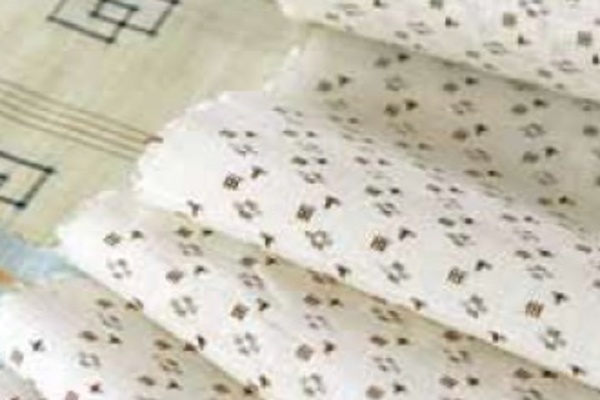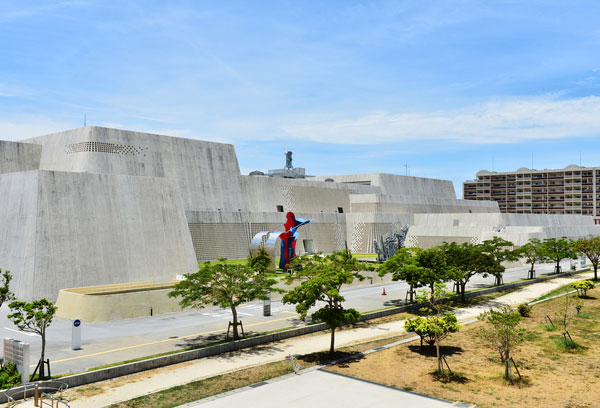
- Woven textiles
- Okinawa
Yaeyama ramie cloth Yaeyama jofu
Traditional patterns floating on the refreshingly white fabric
Natural colors nurtured by the sea and coral reefs of Yaeyama
Description
What is Yaeyama ramie cloth ?
Yaeyama jofu is a fabric produced in the area surrounding Yaeyama ward in Ishigaki city, Okinawa prefecture. This textile is woven with hand-spun ramie threads and used to be produced as a tax to the Ryukyu Kingdom (present day Okinawa) in ancient times. This craft is the only fabric in Okinawa that uses a rubbing and printing technique. As a refreshingly white fabric with dark brown kasuri or ikat patterns, it is used mainly for summer kimono. The threads and dye used for this fabric are fiber from ramie and dye from kuru (the vine of a yam found in Okinawa) which are plants that grow wild in Yaeyama. The fabric is soaked in the ocean as the intense sunlight deepens the color and the seawater makes the white become lighter. These processes make the ikat patterns look even more vivid.
Yaeyama jofu has a dry texture of hand-spun ramie threads that create an airy feel to the fabric. It takes approximately fifty days to make the warp threads for ramie and approximately forty days to make the weft threads that are required to make this craft. A lot of work is required so increasing amounts of artisans are using ramie that has not been handspun for the warp threads.
History
It is known from passages in the Veritable Records of the Joseon Dynasty that people in Yaeyama have been producing ramie fabrics since ancient times. High quality ramie fabric started being officially produced for the Ryukyu Kingdom on the basis of a sketch drawn by a court painter. The Satsuma domain invaded Ryukyu in 1609 and started a poll tax on Yaeyama that was paid in the form of Yaeyama jofu. All of the women on the island started producing the fabric which led the patterns to gradually improve and become more refined. This is how modern day Yaeyama jofu was created. Back then, this craft was so valuable that few people could wear it.
After the poll tax was abolished in 1886, production of this craft started to develop as a regional industry, a new type of loom was invented, and more men became involved in the fabric production. During the Taisho period (1912-1926), an improved loom became available so that the fabric produced had more accurate positioning of the ikat patterns since there was less irregularity in the tension of the threads. Currently, the prefecture of Okinawa and the city of Ishigaki are working together in building a business to cultivate successors of Yaeyama jofu artisans.
General Production Process
- 1. Producing threads from ramie
First of all, the threads have to be made from ramie which belongs to the nettle family and can be harvested four to five times a year when about a meter tall. So as not to harm the plant, the material has to be carefully harvested by soaking in water for several hours before softening and peeling the bark. The peeled bark is soaked in water again and the fiber inside the bark is gently stripped off. The fiber is dried in the shade then put back in water before being shredded into thin threads by hand. A firmer twist is given to the warp threads using a spinning wheel while the weft threads are given a firmer twist from hand weaving.
- 2. Warping
After considering the composition, the layout and design is planned.
- 3. Twisting for ikat threads
There are two methods for making kasuri or ikat threads. One is to paint the threads with a brush and the other is to dye the threads by fastening the marked positions. With the former, a sketch is required for one side of the wooden frame. The warp threads are wound around the wooden frame. The threads are divided into ikat and base threads in accordance with the drawing and which are sorted by length and number of threads. Then the threads are starched and left to dry to prevent the ikat patterns from becoming wrongly positioned or smeared. With twisting, on the other hand, the marked positions on the threads have to be tied with cotton or plastic strings. When the base color is dark, ikat pattern positions are fastened and the base color positions in the weft threads are also fastened. Once the threads are fastened, they are placed in hot water to remove starch from sections that do not require dyeing.
- 4. Dyeing
The dye used for Yaeyama jofu is taken mostly from the plants grown in Yaeyama including kuru, Fukugi tree, mangrove, Acacia confusa, and indigo.
The kuru has to be peeled and grated before being put in boiling water, which is strained to get the reddish brown dye. The leaves of Acasia confusa, which is an evergreen in the pea family, are boiled to make dye of multiple shades from pale to vivid yellow.
Indigo has to be soaked in water with branches still attached and the liquid is fermented with lime to make the dye. The indigo threads need to be lifted from the vat on occasion to expose them to air.
- 5. Winding around the frame
After the threads are dyed, the unfastened warp threads are stretched in accordance with the drawing and put through the reed. Then, they are wound around the wooden frame with thick paper in between so that the positions of the ikat patterns do not move.
- 6. Stencil dyeing
This is a method of dyeing introduced for mass production after the poll tax was abolished. Kuru is grated, pressed, and the extract is dried in the sun to make a condensed dye. A bamboo brush is used to dye the threads with the condensed dye. The number of the weft threads are pulled over the drawing stand and marked with ink to make the standard threads. Then the threads are soaked in water and wound around a wooden frame made to match the fabric width. After drying, the threads are dyed with a bamboo brush. The threads are dyed and dried naturally while they are wound on the wooden frame.
- 7. Winding
The base threads are wound around a part of the machine called jiitsuburu after temporarily putting the threads through reed. A thick paper is used in between the jiitsuburu and the base threads.
- 8. Weaving
The dyed linen threads are set on a loom and woven while making sure that the threads do not dry out. The weft threads are wound around tubes and set in a boat-shaped shuttle. A takabata or traditional treadle-operated tall loom that has a separate wooden frame and jiitsuburu is used for weaving this fabric. The tension on the warp threads can be adjusted with weights so that the patterns do not become out of place.
- 9. Leaving in seawater
When the fabric is woven, it is dried in the sun for about ten days. The colors become more vivid when the fabric is dried in the sun. After drying, the fabric is soaked in seawater for about five hours. This process removes impurities from the fabric and also lightens the color so the ikat patterns settle better. This process is unique to this craft.
- 10. Pounding with a pestle
The woven fabric is wrapped around a round piece of wood and a cotton cloth is wrapped over the fabric. The fabric is placed on a wooden stand and pounded with a pestle. This process improves the fabric texture as it improves the feeling on one’s skin.
Where to Buy & More Information
Okinawa Prefectural Museum & Art Museum

-
Address
-
Tel.+81-98-941-8200
-
ClosedMondays (open if Monday is holiday and closed the next day), December 29 - 31
-
Business Hours9am to 6pm Fridays & Saturdays 9am to 8pm
-
Website
See more Woven textiles
- Nishijin brocade
- Yuki tsumugi silk
- Kurume traditional resist-dyed textiles
- Ojiya chijimi textiles
- Hakata brocade
- Ushikubi tsumugi silk
- Chichibu-meisen silk
- Miyako ramie textile
- Shiozawa tsumugi silk
- Kumejima tsumugi silk
- Omi ramie cloth
- Ryukyu traditional resist-dyed textiles
- Kiryu brocade
- Murayama-oshima tsumugi silk
- Yumihama traditional resist-dyed textiles
- Chibana-hanaori textiles
- Hon-shiozawa silk
- Oitama tsumugi silk
- Ojiya tsumugi silk
- Yaeyama cotton cloth
- Yaeyama ramie cloth
- Honba oshima tsumugi silk
- Shinshu tsumugi silk
- Shuri brocade
- Tama brocade
- Yomitanzan-hanaori textiles
- Isesaki traditional resist-dyed textiles
- Hachio island silk
- Nibutani bark cloth
- Uetsu tilia bark cloth
- Awa-shijira cotton cloth
- Kijoka banana fiber cloth
- Tokamachi traditional resist-dyed textiles
- Tokamachi akashi chijimi textiles
- Yonaguni brocade
- Yuntanza minsa
- Flower pattern textiles
- Oku-Aizu Showa Karamushi Textiles
See items made in Okinawa
- Tsuboya ware
- Miyako ramie textile
- Ryukyu lacquerware
- Kumejima tsumugi silk
- Ryukyu traditional resist-dyed textiles
- Chibana-hanaori textiles
- Yaeyama cotton cloth
- Yaeyama ramie cloth
- Shuri brocade
- Yomitanzan-hanaori textiles
- Ryukyu traditional textiles
- Kijoka banana fiber cloth
- Yonaguni brocade
- Yuntanza minsa
- Flower pattern textiles
- Sanshin































































































































































































































































































